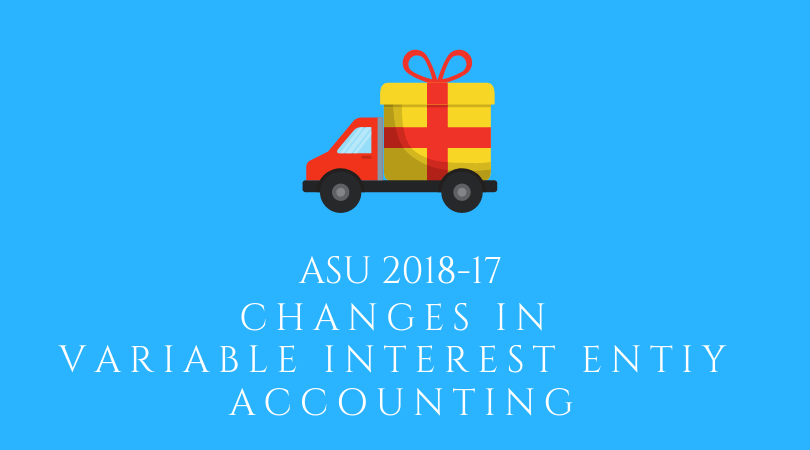It's time for another change to VIE accounting!
The variable interest entity (VIE) considerations just got much easier. FASB is—with ASU 2018-17—providing another get-out-of-jail-free card to private companies.
When FASB originally issued its VIE accounting guidance many years ago, it created a thorny issue for private companies—one almost incomprehensible to anyone but a seasoned CPA. FASB required companies to consider whether entities under common control should be consolidated, even if the reporting entity did not own a majority of the voting stock. While FASB’s intent was noble (it was addressing issues that arose from Enron’s use of special purpose entities), it created one of the most difficult accounting standards ever. In the ensuing years, private companies begged for relief. The first leg of that relief came with the issuance of ASU 2014-07 (more in a moment); the second leg of that relief comes now with ASU 2018-17.
The original VIE accounting guidance issued in the early 2000s required reporting entities to consolidate related companies if certain conditions were met. For example, if a reporting entity rented real estate from a commonly owned company, then consolidation might be required. This original guidance applied to both public and private companies. Public companies tend to have the muscle and knowledge to make these complicated evaluations. Not so for private companies. That’s why private companies asked for relief.
First, FASB had issued ASU 2014-07, Consolidation (Topic 810): Applying Variable Interest Entities Guidance to Common Control Leasing Arrangements. That standard allowed reporting entities, when specified conditions were met, to not consolidate lessee companies. A private company could elect to not apply variable interest entity guidance to a lessor entity if those specified conditions were met.
Then, on October 31, 2018, FASB issued Accounting Standards Update (ASU) 2018-17, Consolidation (Topic 810): Targeted Improvements to Related Party Guidance for Variable Interest Entities. ASU 2018-17 expands the provisions in ASU 2014-07, permitting the accounting alternative to include all private company common control arrangements (see criteria below).
VIE Accounting Alternative
Using 2018-17, a legal entity need not be evaluated by a private company (reporting entity) under the VIE accounting model if all of the following are true:
- The reporting entity and the legal entity are under common control.
- The reporting entity and the legal entity are not under common control of a public business entity.
- The legal entity under common control is not a public business entity.
- The reporting entity does not directly or indirectly have a controlling financial interest in the legal entity when considering the voting interest model (see ASC 810-10-05; under the voting interest model, the usual condition for a controlling financial interest is ownership by one reporting entity, directly or indirectly, of more than 50 percent of the outstanding voting shares of another entity).
The Alternative is an Election
Applying this accounting alternative is an accounting policy election. If the election is made, then the private company must apply the criteria above to all legal entities. If, for example, a reporting entity has consolidated companies A and B due to VIE considerations, the election must be applied to both entities.
Combined Financial Statements (Still an Option)
If a private company reporting entity makes the alternative election, it can still create combined financial statements for entities under common control. For example, if a reporting entity consolidates companies A and B under the prior VIE guidance, it might no longer do so after the election. Nevertheless, the reporting entity could issue combined financial statements. The reporting entity might, for example, issue combined financial statements for the reporting entity and company B (and exclude company A). See ASC 810-10-55-1B.
Entities that Can’t Use the Alternative
The entities that can’t use the VIE alternative (under ASU 2018-17) include:
- Public business entities
- Not-for-profit entities
- Employee benefit plans (within the scope of ASC 960, 962, and 965)
Required Disclosures
A private company that makes the election to use the alternative is required to include information about the relationship of the entities. Those disclosures include (see 810-10-50-2AG, 810-10-50-2AH and 810-10-50-2AI for complete list of disclosures):
- The nature and risks as a result of the reporting entity’s involvement with the legal entity under common control
- How a reporting entity’s involvement with the legal entity under common control affects:
- Financial position
- Financial performance
- Cash flows
- The carrying amounts and classification of the assets and liabilities in the reporting entity’s statement of financial position as a result of its involvement with the legal entity under common control
- The reporting entity’s maximum exposure to loss based on its relationship with the legal entity under common control (if not quantifiable, then that fact should be disclosed)
- If the maximum exposure to loss exceeds the carrying amount of the assets and liabilities, that information is to be disclosed (including the terms of the arrangements)
Effective Dates
For entities other than private companies, the amendments in ASU 2018-17 are effective for fiscal years beginning after December 15, 2019, and interim periods within those fiscal years. The amendments in this Update are effective for a private company for fiscal years beginning after December 15, 2020, and interim periods within fiscal years beginning after December 15, 2021. All entities are required to apply the amendments in this Update retrospectively with a cumulative-effect adjustment to retained earnings at the beginning of the earliest period presented.
Early adoption is permitted.

